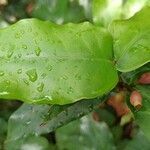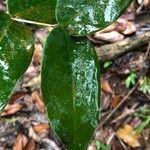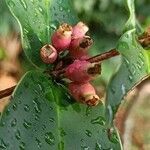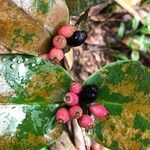Shrubs or trees, 3-6(-12) m tall, few-to many-branched. Stems terete, glabrous. Petiole 5-10 mm; leaf blade oblong to elliptic, 8-11(-16) × 3.8-6(-7.5) cm, leathery, both surfaces glabrous, base cuneate, obtuse, or subround, margin entire, apex acute, obtuse, or retuse. Inflorescences axillary, clustered or shortly cymose, 1.5-3 cm; peduncle 5-12 mm; bracts ca. 0.5 mm, caducous. Pedicel 2-5 mm, glabrous. Hypanthium shallowly cup-shaped, 1.5-3 mm, glabrous. Calyx lobes 4, repand. Petals white or yellowish green but base pale blue, broadly ovate, ca. 2 mm, apex acute. Stamens blue, ca. 2.5 mm; anthers and conic connective 1-1.5 mm, with a small concave abaxial gland. Ovary cup-shaped to ovoid. Fruit pink to dark red and maturing purple to black, obovoid, 1-1.5 cm in diam., smooth and glabrous; exocarp succulent, juicy. Fl. Apr-Aug, fr. Dec-Jan.
More
A shrub or small tree. It grows 3-6 m tall. The stems are angular. The leaves are oblong and 8-11 cm long by 4-6 cm wide. The flowers are in clusters in the axils of leaves. The petals are white or greenish yellow but pale blue towards the base. The fruit are pink to red and turn purple to black as they ripen. They are oval and 1-1.5 cm across. They are juicy.




